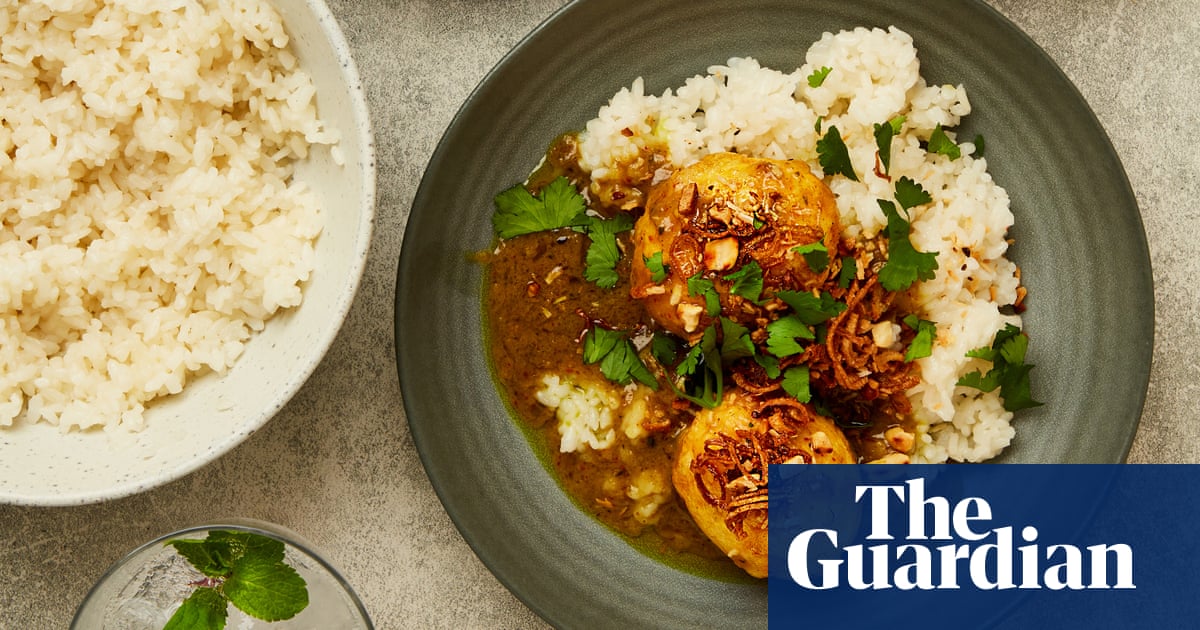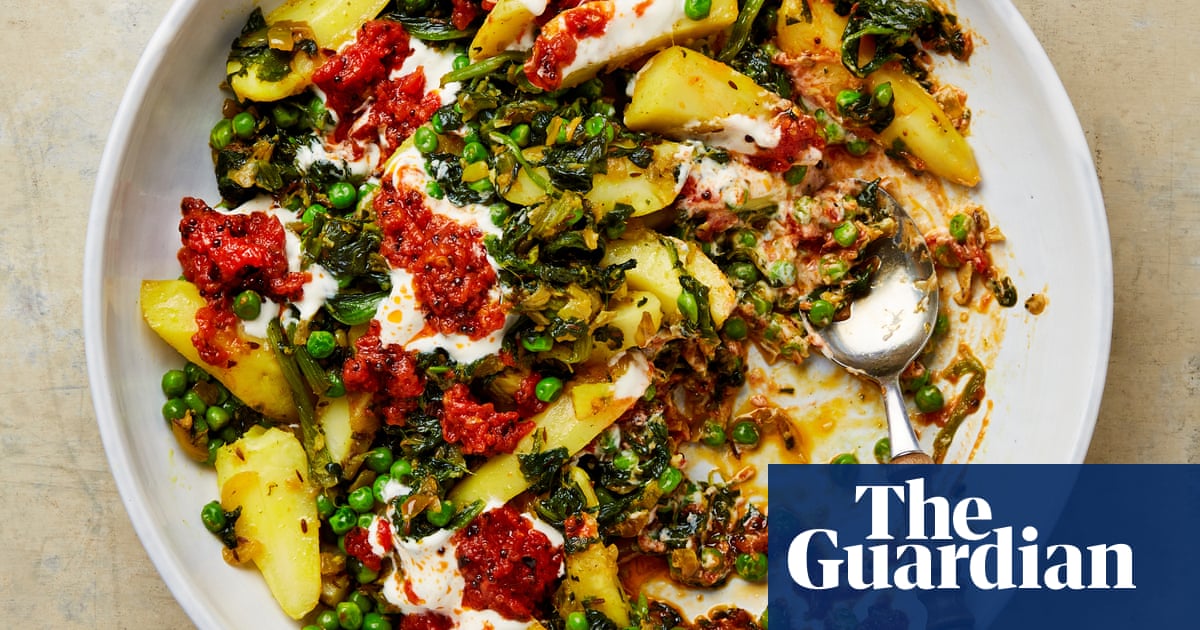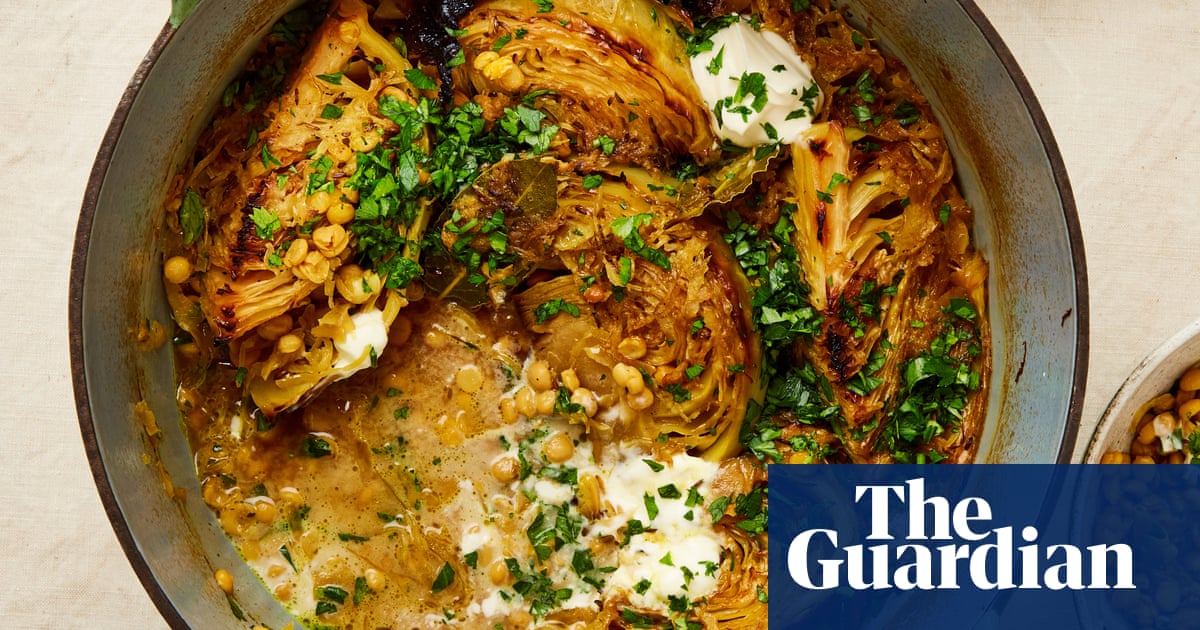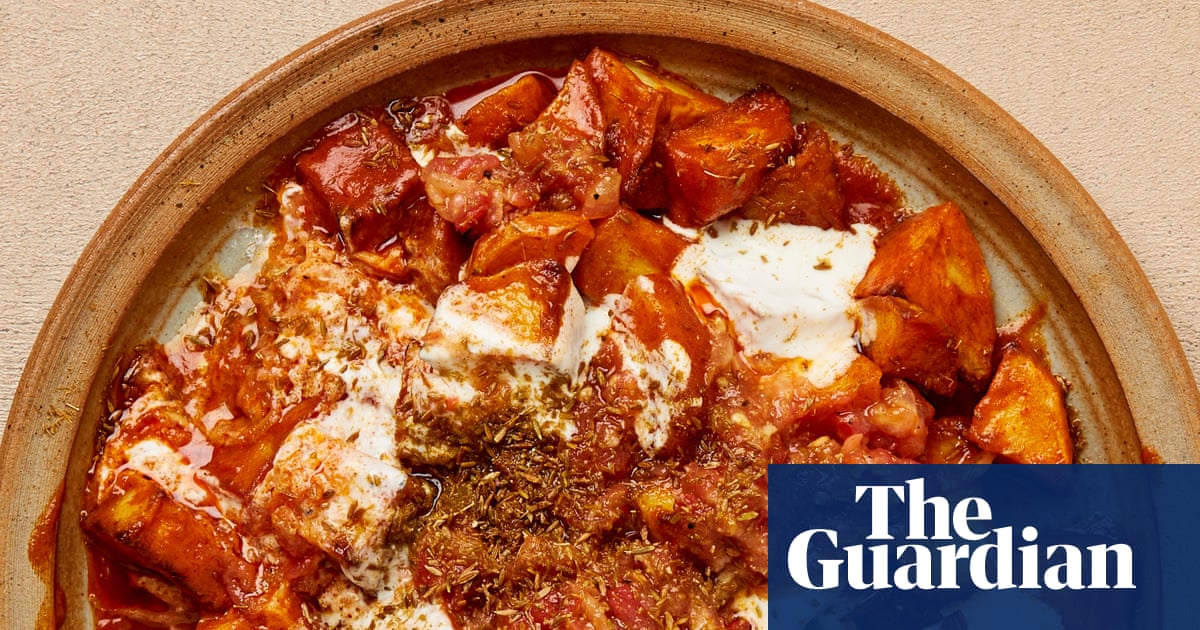
At this time of year, with the longest day of the year earlier this week, thoughts of long evenings eating tapas are rarely far from my culinary thoughts. Making tapas often requires a good chunk of time in the kitchen – salt cod, croquetas and allioli do take a fair while to make. But, to my mind, that’s all part of the occasion: potter about the kitchen, slip off for a siesta, and possibly bring the sundowner forward an hour or so to enjoy while you prep … ¡Salud!
Salt cod with grated tomatoes and dill oil (pictured top)
Salt cod, or bacalao, is one of those things that sounds way harder to make than it actually is. Try it once – not least to show yourself how easy it can be – and you’ll soon be doing so again to show off to friends. Serve with crusty bread and a big, leafy salad.
Prep 25 min
Cure 1 hr+
Cook 15 min
Serves 4
500g skinless cod loin, cut into 4 equal pieces
¾ tsp caster sugar
Flaked sea salt
160ml olive oil
3 garlic cloves, peeled – 2 lightly bashed with the flat of a large knife, the other crushed
1 lemon – zest finely pared off in 5 strips, then juiced, to get 1½ tbsp
4 plum tomatoes (400g net)
1 shallot, peeled and cut into thin rounds (30g net)
10g fresh dill leaves
½ tsp caraway seeds, toasted and lightly ground in a mortar
½ tsp aleppo chilli
First, cure the cod. Grind the sugar and two teaspoons of flaked salt in a mortar until almost fine. Pat dry the cod pieces and put them on a tray. Evenly coat the fish with the salt mixture and leave to cure at room temperature for an hour or two – don’t leave it for much longer, or it’ll be too salty.
Once the cod has cured, heat the oven to 180C (160C fan)/350F/gas 4.
Rinse the fish well under cold running water, then pat dry and put in a small, ovenproof saute pan in which it fits snugly. Pour in 100ml of the oil, add the bashed garlic and strips of lemon zest and cover with a sheet of greaseproof paper. Bake for 12 minutes, until it’s cooked through, then take out of the oven, remove and discard the paper and set aside for five minutes.
Meanwhile, grate the tomatoes into a bowl on the coarse side of a grater and discard the skin. Stir in half a teaspoon of flaked salt, then pour into a small sieve set over a bowl and leave to drain for five minutes. Discard the tomato water (or save it for another use), then put the pulp in a bowl and stir in two tablespoons of oil, the crushed garlic and a tablespoon of the lemon juice.
Put the shallots in a small bowl with the remaining half-tablespoon of lemon juice and and an eighth of a teaspoon of salt, stir to combine then put to one side to pickle gently.
To make the dill oil, put the remaining two tablespoons of oil and the dill in the small bowl of a food processor and blitz until the mix green and almost smooth (alternatively, do so with a pestle and mortar).
Spoon the tomato on to a lipped platter, then, using a spatula, gently lift the cod pieces from the oil (save the confit oil for frying other seafood) and lay on top of the tomato. Spoon over the dill oil, scatter the shallots, caraway and chilli on top, and serve.
Goat’s cheese croquetas with marmalade allioli
Croquettes are made and loved throughout Europe, and in Spain, ham, cheese or potato croquetas are especially popular. This recipe marries salty goat’s cheese with bitter-sweet marmalade, and is a great snack to share.
Prep 20 min
Rest 1 hr 30 min
Cook 45 min
Makes 30
300g king edward potatoes (ie, about 2), peeled and cut into 3cm dice
Fine sea salt and black pepper
300g soft goat’s cheese, rind removed, roughly chopped (230g)
20g manchego, rind removed, finely grated
½ tbsp rosemary leaves, finely chopped
10g (3⅓ tbsp) chives, finely chopped
2-3 lemons – zest finely grated, to get 1½, juiced, to get 2 tbsp, and the rest cut into wedges
4 eggs, beaten
75g plain flour
150g panko breadcrumbs
100ml vegetable oil, for deep-frying
For the allioli
2 garlic bulbs
2 tbsp seville (or other bitter orange) marmalade
2 eggs yolks
75ml olive oil
75ml vegetable oil
Heat the oven to 240C (220C fan)/475F/gas 9. Trim the top fifth off both garlic bulbs, to expose the cloves, then sprinkle over an eighth of a teaspoon of salt and wrap individually in squares of foil. Roast for 20 minutes, until soft, then remove, leave to cool and put in the fridge with all the other allioli ingredients – if they’re fridge-cold, the allioli’s texture will be better.
Meanwhile, put the potatoes and a tablespoon of salt in a medium-sized saucepan, add a litre of water and bring to a boil. Turn down the heat to medium and cook for 15 minutes, until soft. Drain into a colander, leave to steam dry for five minutes, then return to the dry pan and mash smooth. Return to a medium heat and add the cheeses, rosemary, chives, an eighth of a teaspoon of salt and a good grind of pepper, and cook, stirring constantly, for five minutes, until the cheese melts. Take off the heat and stir in the lemon zest.
Put a large piece of reusable kitchen wrap on a work surface and tip the potato mixture into the centre. Roll up to encase the filling, twist the ends to seal, roll into a roughly 2½cm-thick sausage and refrigerate for an hour.
Meanwhile, make the allioli. Squeeze the garlic flesh from its papery skins, put this in a small food processor with the marmalade, lemon juice, egg yolks and half a teaspoon of salt, and blitz smooth. With the motor running, slowly pour in the olive and vegetable oils until you have an emulsified mayonnaise, then transfer to a small bowl and refrigerate.
Now for the croquetas. Put the flour, breadcrumbs and eggs in three separate large bowls. Unwrap the potato mixture and cut it into 3cm lengths each weighing about 15g. Working with four croquetas at a time, roll them in the flour, submerge in the egg, shake off any excess, then coat in the breadcrumbs. Set aside on a tray while you repeat with the remaining croquetas mix, then refrigerate for 20 minutes.
Put the 100ml vegetable oil in a large frying pan on a medium-high heat. Once it’s hot, add half the croquetas and fry for 90 seconds to two minutes on each side, until golden and heated through. Drain on a plate lined with kitchen paper, sprinkle with a pinch of salt and repeat with the remaining croquetas.
While the croquetas are still hot, arrange them on a platter and serve with the allioli and lemon wedges on the side.
Burnt aubergine and red pepper fideuà with picada
In many parts of Spain, a picada is usually used to season a dish while it’s cooking. I use it here as a condiment, to bring some extra freshness to the finished dish. To save time, by all means use shop-bought roast aubergines and peppers instead.
Prep 25 min
Cook 1 hr
Serves 6-8
2 tbsp olive oil, plus 1 tsp extra
3 large red peppers (335g)
2 aubergines (600g)
Fine sea salt and black pepper
250g wheat vermicelli pasta nests (or angel hair pasta), broken into roughly 3cm lengths
2 onions, peeled and thinly sliced
3 garlic cloves, peeled and thinly sliced
1 tbsp tomato paste
½ tsp paprika
1 large plum tomato, roughly grated and skin discarded (180g)
500ml vegetable stock
1 lemon, cut into 6 wedges
For the picada
1 slice stale bread, crusts removed (35g)
60ml olive oil
35g blanched almonds
1 cascabel chilli, stem and seeds removed, flesh roughly crushed
15g (4 tbsp) flat-leaf parsley leaves, finely chopped
5g dill leaves, finely chopped
1 garlic clove, peeled and crushed
Set a griddle pan on a high heat and ventilate your kitchen. Rub the extra teaspoon of oil all over the peppers and aubergines, then lay them in the hot pan and grill, turning occasionally, for 20-30 minutes, until charred all over; remove each vegetable as it’s ready. Transfer to a tray and leave to cool. Once the peppers and aubergines are cool enough to handle, peel off and discard the skins, remove and discard the stems, pith and seeds from the peppers, then tear the pepper and aubergine flesh into 1cm-thick strands. Put on a large plate, scatter over an eighth of a teaspoon of salt and set aside.
Meanwhile, put a large, 28cm, nonstick frying pan for which you have a lid on a medium-high heat. Add the vermicelli, and toast, stirring frequently, for three to four minutes, until mostly deeply golden but still with a few untoasted strands. Tip the pasta into a bowl.
Return the pan to the heat, add the remaining two tablespoons of oil, then saute the onions, stirring occasionally, for 15 minutes, until lightly golden and soft. Stir in the garlic, tomato paste and paprika, cook for another three minutes, until fragrant, then mix in the vermicelli. Add the grated tomato, stock, a teaspoon of salt and a good grind of pepper, then arrange the aubergine and pepper strands in six or seven piles on top, leaving gaps in between for the pasta to peek through. Cover the pan, turn down the heat to medium, and leave to simmer for 10-12 minutes, until all the liquid has been absorbed.
To ensure a crisp base, remove the lid, turn down the heat to medium-low and cook undisturbed, save for turning the pan once halfway, for 10-12 minutes, until the pasta at the edge of the pan starts to curl inwards. You want the base to crisp up but not burn. Take off the heat and set aside to rest for 10 minutes.
Meanwhile, make the picada. Put a small frying pan on a medium heat, toast the bread for a minute or two on each side, until lightly coloured, then transfer to a plate.
Put the oil and almonds in the same pan and fry for three to four minutes, until lightly golden. Stir in the cascabel chilli, take off the heat, leave to cool, then tip into a small food processor. Blitz the cascabel mix until almost fine, then crumble in the bread and pulse to rough crumbs. Tip into a small bowl and stir in the parsley, dill and a quarter-teaspoon of salt.
Spoon half the picada over the fideuà and serve straight from the pan with the lemon wedges and remaining picada alongside.












